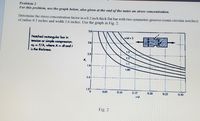
Elements Of Electromagnetics
7th Edition
ISBN: 9780190698614
Author: Sadiku, Matthew N. O.
Publisher: Oxford University Press
expand_more
expand_more
format_list_bulleted
Concept explainers
Question

Transcribed Image Text:**Problem 2**
*For this problem, use the graph below, also given at the end of the notes on stress concentration.*
Determine the stress concentration factor in a 0.2-inch thick flat bar with two symmetric grooves (semi-circular notches) of radius 0.3 inches and width 2.6 inches. Use the graph in Fig. 2.
---
### Explanation of the Diagram:
The diagram provided, labeled as Fig. 2, is a graph used to determine the stress concentration factor (\( K_t \)) for a notched rectangular bar under tension or simple compression. The stress concentration factor is used to quantify how much stress is increased due to the presence of notches or grooves.
- **Axes of the Graph:**
- The x-axis represents the ratio of notch radius to notch width (\( r/d \)).
- The y-axis represents the stress concentration factor (\( K_t \)), ranging from 1.0 to 3.0.
- **Curves on the Graph:**
- Several curves are plotted, corresponding to different \( w/d \) ratios (width of the bar over diameter of the notch) with one labeled as \( w/d = 3 \).
- The curves indicate how \( K_t \) changes based on the ratio \( r/d \).
- **Inset Image:**
- The inset illustrates a notched rectangular bar with symmetric grooves under tension, showing dimensions and load directions.
- **Equation Provided:**
- \( \sigma_0 = F/A \), where \( A = dt \) and \( t \) is the thickness.
To solve for the stress concentration factor using your specific dimensions, locate the point on the curve that corresponds to your \( r/d \) value and read off the associated \( K_t \).
Expert Solution
This question has been solved!
Explore an expertly crafted, step-by-step solution for a thorough understanding of key concepts.
This is a popular solution
Trending nowThis is a popular solution!
Step by stepSolved in 2 steps

Knowledge Booster
Learn more about
Need a deep-dive on the concept behind this application? Look no further. Learn more about this topic, mechanical-engineering and related others by exploring similar questions and additional content below.Similar questions
- Part 1 At a temperature of 60°F, a 0.05-in. gap exists between the ends of the two bars shown. Bar (1) is an aluminum alloy [E = 10,000 ksi; v = 0.32; a = 12.5 x 106/°F] bar with a width of 2.7 in. and a thickness of 0.65 in. Bar (2) is a stainless steel [E = 28,000 ksi; v = 0.12; a = 9.6 x 106/°F] bar with a width of 1.6 in. and a thickness of 0.65 in. The supports at A and C are rigid. Assume h₁=2.7 in., h₂=1.6 in., L₁=26 in., L2=40 in., and 4 = 0.05 in. Determine (a) the lowest temperature at which the two bars contact each other. (b) the normal stress in the two bars at a temperature of 225°F. (c) the normal strain in the two bars at 225°F. (d) the change in width of the aluminum bar at a temperature of 225°F. (1) L₁ h₁ Answer: Tcontact= B Save for Later A eTextbook and Media h₂ Determine the lowest temperature, Tcontact: at which the two bars contact each other. (2) L2 °F Attempts: 0 of 5 used Submit Answerarrow_forwardCompute the elongation, in %, of a cylindrical copper rod if it is cold worked such that the diameter is reduced from 15.9 mm to 10.4 mmarrow_forwardSpecify the Ø1.00-inch pin perpendicular to the top surface of the plate in Fig. 6-19 within a tolerance of .015 at MMCarrow_forward
arrow_back_ios
arrow_forward_ios
Recommended textbooks for you
 Elements Of ElectromagneticsMechanical EngineeringISBN:9780190698614Author:Sadiku, Matthew N. O.Publisher:Oxford University Press
Elements Of ElectromagneticsMechanical EngineeringISBN:9780190698614Author:Sadiku, Matthew N. O.Publisher:Oxford University Press Mechanics of Materials (10th Edition)Mechanical EngineeringISBN:9780134319650Author:Russell C. HibbelerPublisher:PEARSON
Mechanics of Materials (10th Edition)Mechanical EngineeringISBN:9780134319650Author:Russell C. HibbelerPublisher:PEARSON Thermodynamics: An Engineering ApproachMechanical EngineeringISBN:9781259822674Author:Yunus A. Cengel Dr., Michael A. BolesPublisher:McGraw-Hill Education
Thermodynamics: An Engineering ApproachMechanical EngineeringISBN:9781259822674Author:Yunus A. Cengel Dr., Michael A. BolesPublisher:McGraw-Hill Education Control Systems EngineeringMechanical EngineeringISBN:9781118170519Author:Norman S. NisePublisher:WILEY
Control Systems EngineeringMechanical EngineeringISBN:9781118170519Author:Norman S. NisePublisher:WILEY Mechanics of Materials (MindTap Course List)Mechanical EngineeringISBN:9781337093347Author:Barry J. Goodno, James M. GerePublisher:Cengage Learning
Mechanics of Materials (MindTap Course List)Mechanical EngineeringISBN:9781337093347Author:Barry J. Goodno, James M. GerePublisher:Cengage Learning Engineering Mechanics: StaticsMechanical EngineeringISBN:9781118807330Author:James L. Meriam, L. G. Kraige, J. N. BoltonPublisher:WILEY
Engineering Mechanics: StaticsMechanical EngineeringISBN:9781118807330Author:James L. Meriam, L. G. Kraige, J. N. BoltonPublisher:WILEY

Elements Of Electromagnetics
Mechanical Engineering
ISBN:9780190698614
Author:Sadiku, Matthew N. O.
Publisher:Oxford University Press

Mechanics of Materials (10th Edition)
Mechanical Engineering
ISBN:9780134319650
Author:Russell C. Hibbeler
Publisher:PEARSON

Thermodynamics: An Engineering Approach
Mechanical Engineering
ISBN:9781259822674
Author:Yunus A. Cengel Dr., Michael A. Boles
Publisher:McGraw-Hill Education

Control Systems Engineering
Mechanical Engineering
ISBN:9781118170519
Author:Norman S. Nise
Publisher:WILEY

Mechanics of Materials (MindTap Course List)
Mechanical Engineering
ISBN:9781337093347
Author:Barry J. Goodno, James M. Gere
Publisher:Cengage Learning

Engineering Mechanics: Statics
Mechanical Engineering
ISBN:9781118807330
Author:James L. Meriam, L. G. Kraige, J. N. Bolton
Publisher:WILEY